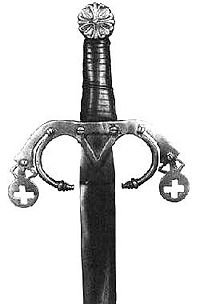- Carracks black sword
-
The Carracks Black Sword sometimes called Crab Sword, is a type of sword invented in Portugal, during the 15th century, designed to be used by soldiers and sailors in ships and caravels in the Age of Discovery.[1]
It is characterized by having a guard with two protective rings, with the guard terminals in the form of two flat drops, the referred guard terminals facing toward the tip of the blade, and forming round large plates, sharpened to the point where they can be used as extra blades, because they can be convenient in close combat.
The protective rings, in addition to the protective function of the fingers, still allowed a way of handling the sword with angles of attack up to 160º, which drastically changed the form of combat. Due to this configuration, the sword could be used in 50% of cases for coup and in 50% of cases for thrust. On the other hand the protective ring also served to hold and break the opponent's blade.
These swords were painted black not to reflect the light and denounce their presence on ships, avoiding also its rusting when used near salt water.
It was also known by Portuguese soldiers as colhona (which in rude Portuguese means approximately “big balls”) due to the roundshape of the terminal plates, reminiscent of a representation of the testicles in a phallic symbol in the form of sword.
This type of sword will have appeared between 1460 and 1480 and saw much of its use in Portuguese trading cities in Africa, coming to be used as a symbol of honor by the local chiefs.
See also
- Portuguese Discoveries
Notes
- ^ [|Daehnhardt, Rainer] (1997). Homens Espadas e Tomates. Rua Maria, 48-3º - 1170 Lisbon: Publicações Quipu. pp. 255. ISBN 972-8408-01-3. http://www.zefiro.pt/livro_homensespadasetomates2ed.htm. Retrieved 2011-09-08.
Categories:- Swords
- Portuguese inventions
Wikimedia Foundation. 2010.

